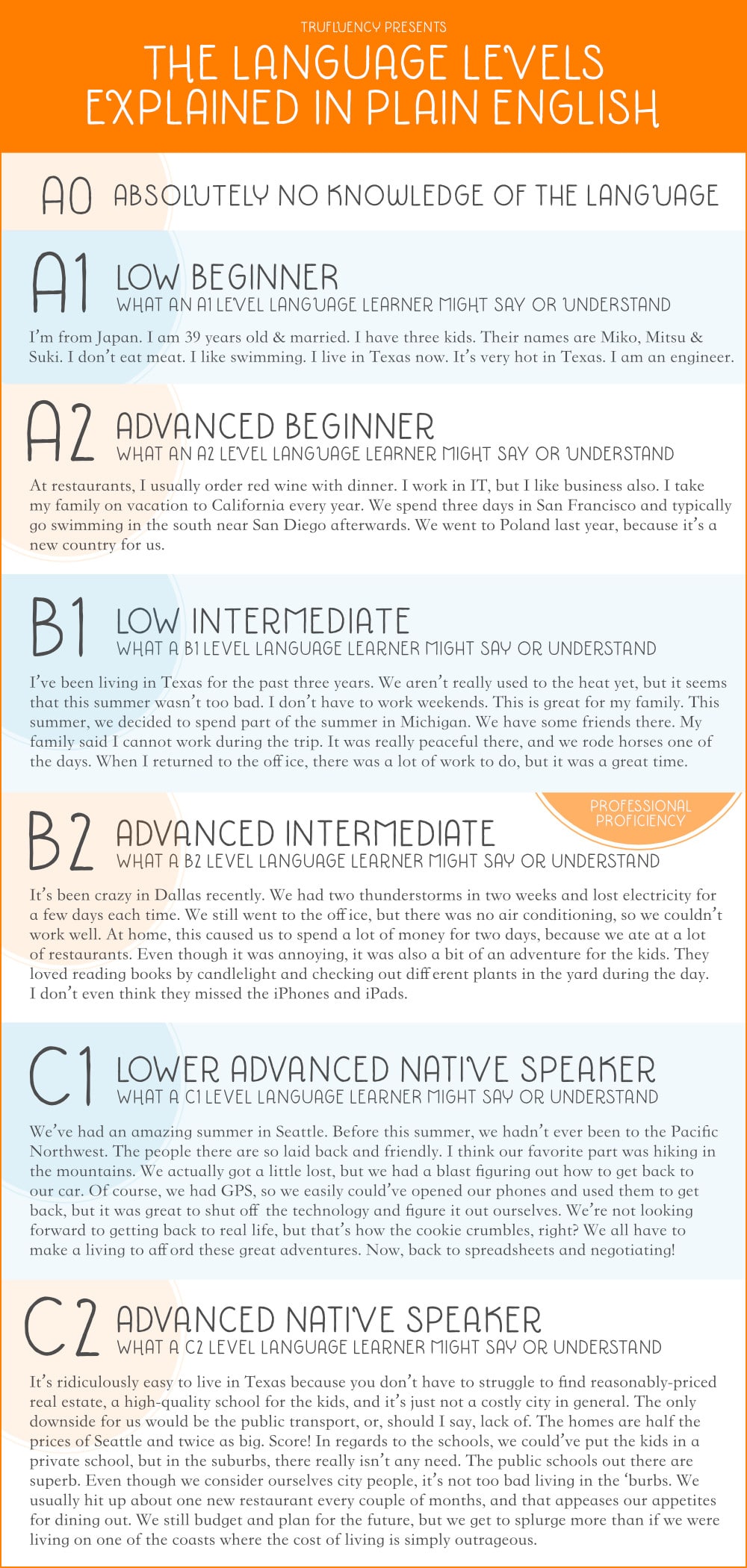What You Need to Know About Common European Framework of Reference for Languages (CEFR)
According to Cambridge English, CEFR is an international standard for determining language ability on a six-point scale. The scale goes from A1, beginner to C2 which means you’ve mastered the language. Some use A0 as a scale but this means you have no knowledge of the language. According to Cambridge English, “These descriptors can be used to set clear targets for achievements within language learning, to help define language proficiency levels and to interpret language qualifications”.
According to the Council of Europe, for each language level, speakers are judged on reception, interaction, and production. Reception is broken down into listening and reading. So for someone who is A1, they should be able to listen and understand basic phrases if the speaker is speaking slowly as well as read and understand notices. Interaction is broken down into speaking and written interaction and the same thing goes for production.
Here is a breakdown of each language level according to the Council of Europe website.
What Can I Do With The Levels?
What is interesting about these language levels is that two speakers could be at the same level but have different abilities. For example, a student who has recently reached the B1 level is far behind someone finishing up their B1 level. However, since the second student has not finished their B1, they’re still considered B1 even though they have more knowledge of the language than student one. Imagine that the B1 level is about 150 to 200 hours of time with the language, so someone just starting is about 150 to 200 hours of work behind someone who is just finishing the level of B1.
The level you need to achieve depends on your language learning goals. According to this article, to do a job with limited communication such as farm work, manual work in factories, or warehouses A2-B1 will be sufficient. For jobs in a hotel, bar, restaurant, or café, a B1/B2 should be sufficient. More professional jobs, like salesperson, CFO, executive, a C1, or higher would be preferred to lead efficiently and clearly.
The time it takes to achieve mastery of each level varies. According to the English Profile, A1 will need 90-100 guided learning hours while C2 will take 1000-1200 guided learning hours.
You’ll know what level you are at by doing a language placement test.
Why is the CEFR Important and Who Uses It?
According to an article, CEFR is used as the standard way of determining proficiency in languages in Europe. This is especially true for academic purposes and so you could use the scale on your CV to represent your language level. However, the article noted that CEFR is still not understood that well in professional or corporate settings and so if you’d like to use it for that reason include, “level descriptor, a standardized test score, and examples of instances in which you used your language skills”.
The CEFR is used in both the public education sector and private language learning schools in Europe. It has replaced other leveling systems used in foreign language teaching. While it may be more popular in Europe, some Asian countries, as well as Latin American countries, are adopting CEFR for their education system.
What do I Need to Know About ACTFL?
ACTFL stands for the American Council on the Teaching of Foreign Languages. They measure speaking, writing, listening, and reading in daily situations as well as in a spontaneous context or non rehearsed context. There are 11 levels that range from novice to distinguished. We’ll briefly outline them.
Novice is broken down into novice low, novice mid, and novice high. According to ACTFL proficiency guidelines, in terms of speaking, “Novice-level speakers can communicate short messages on highly predictable, every day topics that affect them directly”.
Intermediate is broken down into intermediate low, intermediate mid, and intermediate high. According to the ACTFL guidelines, speakers at this level will have the “ability to create with the language when talking about familiar topics related to their daily life”.
According to the proficiency guidelines, advanced is split up into advanced low, advanced mid, and advanced high. When it comes to speaking, speakers at this level should be able to “engage in conversation in a clearly participatory manner in order to communicate information on autobiographical topics, as well as topics of community, national, or international interest.”
The penultimate level is superior. Speakers at this level, according to the proficiency guidelines, “are able to communicate with accuracy and fluency in order to participate fully and effectively in
conversations on a variety of topics in formal and informal settings from both concrete and abstract perspectives.”
Finally, there is distinguished. The guidelines state that these speakers, “are able to use language skillfully, and with accuracy, efficiency, and effectiveness”.
ACTFL is typically used in academia. According to Language Testing, “[ACTFL] [is] the standard measure of proficiency in academia and international business settings, and [is] recognized by all government agencies”.
ACTFL offers several proficiency tests such as the ACTFL Reading Proficiency Test (RPT) which measures your reading ability in a language.
Does TruFluency Use ACTFL or CEFR?
We use CEFR for the most part since it is more widely used and TruFluency works with individuals and companies throughout the globe. Every language textbook also has the CEFR levels in it, making it easy to choose relevant material for the level needed. However, we easily translate an ACTFL score to CEFR using this. For example, a Novice High on the ACTFL scale would be an A1 for CEFR.
Why do we take placements tests? What are they used for?
Placement tests come in handy to show level primarily for a job or moving to a country to live. Placement tests can also be done for personal reasons and you can take a test in order to attain a certain level or show your progress throughout a course or time with a private tutor.
Naturally, each language has a different test. We will go over the most commonly taken tests.
DEFL (Diploma in French Language Studies) French
DELE (Diplomas en Español) Spanish
JPLT – Japanese Language Proficiency Test
TOEFL – Test of English as a Foreign Language for Academic English
TOEIC – The Test of English for International Communication for Business English
Do you need to take one of these tests to know you are fluent or making progress in your language course or with your private tutor?
Not necessarily. Remember, these are academic tests – you might speak a language well, but not necessarily speak it academically (nor would you often need to). So these academic or business tests should not be used for those students that have the goal of conversational fluency in a foreign language. We wouldn’t want you to become disappointed that you do not sound like a Spanish professor after years of conversation classes unless it is your goal to sound like a Spanish professor.
Make sure you talk about your goals to your instructor and be clear about what you want to achieve. If you want to speak to your husband’s family in Mexico, there may be no need to take one of these academic tests at all. But if you are trying to get a job in Mexico as the head of marketing, you may want to ensure you are prepared to go over the marketing strategy, and the DELE test for Spanish will truly help you with that.
At TruFluency, we believe you should be specific about your goals from the beginning so that you ensure every lesson is relevant. We’ve seen companies request a TOEFL test from their employees, not realizing that this is a test for universities. So the questions and the conversations are about college life. I do not think this is a relevant study for someone who is 45 years old and who will be the head of the accounting department in Chicago. Make sure to be very clear about your language goals with your instructor from the beginning, so that you learn exactly what you need and only take tests that will help you reach your goals.
If you’re ready to learn a language in order to have real conversations with people, contact us, and let us help you with your language learning journey. Give us a call or take a trial class for just $35 and let your private fluency coach make a specific plan for your fluency goals.






